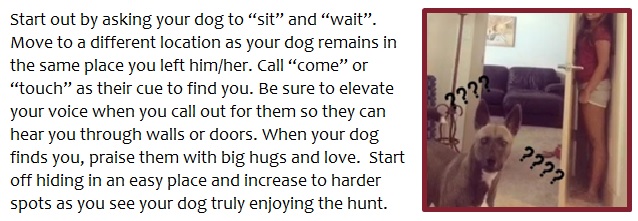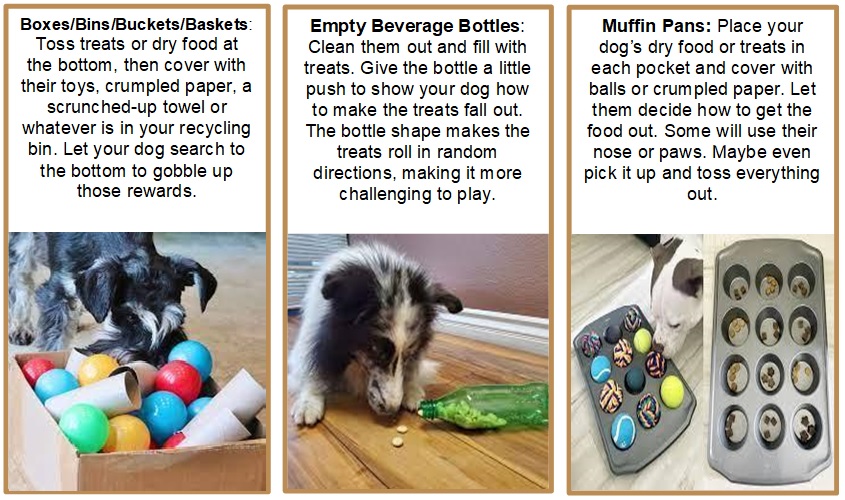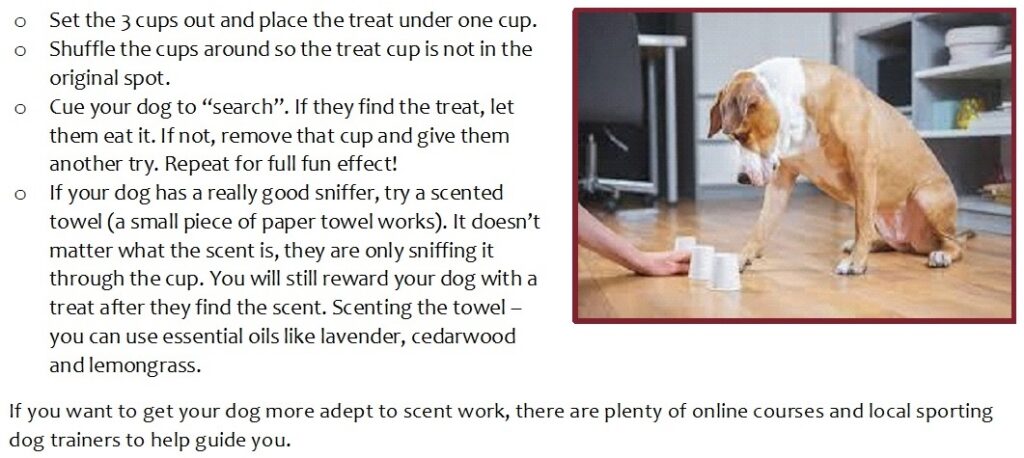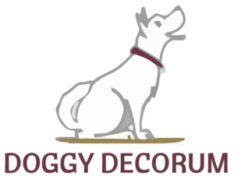Hello, dog lovers!
After a year of my new and improved website being up and running, I’m finally ready to get my blog rolling. This will be a resource center for you to access free training tricks and tips for your puppies and dogs. This month, we will be focusing on indoor dog activities during the winter months. If you haven’t spent time training your puppies and dogs with the basic obedience skills, these could be helpful for some of the below games. If you need some professional help, click here to see my programs.
Winter is a great time to teach these skills, since I do everything in your home where there are no distractions.
So lets get your canine friend’s brains working…

Which would you say describes your dog’s energy level?
Low/Couch Potato
Medium/Either On or Off
High/Related to the Energizer Bunny
Dogs at all life stages have a certain amount of energy to burn through every day based on these factors:
- Breed – working, herding, toy, hound, sporting, non-sporting, terrier, and mixed
- Age – young puppy, adolescence, adult and senior
- Food – dry, wet/canned, cooked, fresh/raw
From the investigative puppy, to the dog who thrives on jogging with you every morning, or the dogs who prefer to lounge in the sunny glow and take in the world from the window, they all have a daily energy bank that needs to be depleted. To ensure our dogs live a healthy, optimal life we have to provide them with outlets to stimulate their physical and cognitive needs.
Please remember that patience and consistency will help dogs learn new activities. If they seem disinterested in one activity, try another. Dogs don’t have to undergo professional training to complete these activities. I have provided a great basis for positive reinforcement training techniques to be introduced to dog(s) and trainer (you) to set a good foundation. As always, I’m here to help.
Here are some of my favorite physical and mental activities for you and your dog to enjoy in unfavorable weather conditions.
Indoor Physical Exercises for Dogs
Physical exercise for dogs is very important. It is any type of movement that gets the blood pumping. Dogs do not require endurance exercise like humans, so keep these activities short (especially when teaching a new skill). Additionally, some dogs might lose interest if they don’t enjoy the activity or, conversely, become obsessed. I’ve seen many cases where dogs are obsessed with playing fetch and won’t play with anything else or with other dogs. Diversification offers healthy stimulation and options to prevent this.
DISCLAIMERS: To avoid injuries, the activities described below are low impact and are pared down for use in a smaller space indoors. You can determine how high or hard you play based on your puppy or dog’s age and breed size. Puppies under 7 months (for small/medium breeds) – 11 months (large to x-large breeds) should avoid jumping too high as their muscles and bones are not developed enough to withstand the pressure of landing.
Obstacle Course – Under, around, and over
Place random objects in a maze-like fashion to lure your puppy under, around and over. You can also purchase a small agility set made for indoor use. The goal is to keep your puppy moving through the course while they focus on your lure. What is a lure? That is your hand holding a treat in front of your pup’s nose to draw them along in the direction you need them to go. Below is an example using your kitchen chairs and pillows. Start off easy before increasing the difficulty. For small breeds, you can lure your pup under the chairs instead of around. For large breed puppies, you can place a broom stick through the chair legs’ cross bars to lure your puppy to jump over instead of using pillows.
Cues: “under”, “around” and “over”

Fetch
This is a common game that can be played with any age dog. The goal is to throw a ball or toy and have the dog bring it back to you. Keep in mind that not all dogs enjoy fetch.
Start out with 2 balls or toys of your pup’s liking (a squeaky toy works best for puppies). Toss one a few feet away to keep them focused. When they have the ball/toy, kneel down and call your pup by their name to you in a very enthusiastic voice. Additionally, you can wave them into your lap. When they approach you, show them the second ball/toy to try to take the one they have from them. This is the tricky part because he/she doesn’t understand why we are taking the toy back. By using two toys, they will drop the first one in hopes you will toss the second.
Repeat this process for several throws or as long as your dog wants to play. If your dog does not offer you the ball/toy after using a second as collateral, try using a treat to trade. Toss the treat on the floor near your pup to encourage them to drop the toy and search for the treat. As your pup gets better at fetch, you can toss the ball/toy further and further away.
Cues: “get” the ball/toy and “give” me the ball/toy
Jumping for Joy with Beach Balls, Bubbles or Balloons
The goal here is to allow them to expend energy by jumping to engage the object. We’ve all seen cute videos of dogs jumping to catch the bubbles or bopping their noses at balloons. This is your chance to capture your own puppies or dogs jumping for joy in this activity.
Practice Recall with Hide and Seek
The goal is to offer a fun way to introduce or reinforce a few obedience cues. By playing this game often, it should significantly improve his/her recall to come to you from any location or distance.

Cues: “sit/wait”, “come” and/or “touch”
Tug of War
This game can be confusing to some dog parents as they might have been told it teaches dogs to be aggressive. On the contrary, this is a natural game all puppies and dogs do to practice impulse control, build confidence and strengthen the bond with their humans or doggy friends. The key is to always let them win! Most dogs will take turns at who wins. Some are pushier. Always supervise if you let your dogs play this game together. If it is between you and your dog, here are a few tips:

Chase
The goal is to let them chase you. A no- brainier, this game is a fun way to teach your dog that running to you is a GOOD behavior. This game is great for those struggling with dogs who won’t “come when called”. Dogs follow each other. They rarely run towards each other when already engaging in chase. It’s counterproductive. So, teach your dogs that coming to you is fun and rewarding.
It also serves as a safety behavior if they run out the front door. Get them excited to chase you by calling their name, saying “come” repeatedly, or making funny noises. Most dogs are curious by noises and will want to investigate. So, make those kissy sounds, practice your silly duck calls and whistles, even clap your hands. Act silly enough that your puppy or dog will chase you with sheer glee. Additionally, to encourage them to run towards you, stand sideways or with your back almost towards them as you call out for them.
Now that we’ve discussed a few physical activities that will get their blood pumping, let’s talk about some mental exercises for dogs.
Indoor Mental Exercises for Dogs
The canine’s brain is their survival instinct toolbox. It’s designed to keep them safe, practice play, find food, and when trained correctly, to live cooperatively with humans. Your dog’s natural instinctual behaviors make them a smart and calculated creature. If not channeled correctly, their mental energy can be applied to unwanted behaviors like opening the trash can for a snack, or picking up a shoe for play.
It’s imperative that we allow our dogs to practice their natural instincts to keep their cognitive skills on point. Just like humans, a sharp mind is a healthy mind and perhaps aids in longevity. What I’m referring to is called Canine Enrichment.
Canine Enrichment (CE) are activities that use one or more senses to complete the game. For example, training a drug sniffing dog to detect drugs in a suitcase is along the lines of canine enrichment. CE games are designed to let your dog use the skills they were born with to build confidence, teach focus, prevent boredom, tired them out, and reduces stress or anxiety. Some games are also a great way to keep your dog busy when you are not home or not able to pay them full attention. Let’s look at some of my favorites:
Food/Treat Dispensing Toys
You’ve heard of the Kong ™ Toys that you fill with food and freeze, right? There is a plethora of these types of puzzle toys on the market these days to keep your dogs foraging until the end of time.
But if you haven’t bought any treat dispensing toys yet, here are some ways to use every day things in your home:

Toy Clean Up
The goal is to get them to place their toys in their toy bin. You can start with a few toys and increase to more if your dog has a large variety of toys. This game has three easy steps
- Teach your dog the names of their toys. Sit your dog and show them one toy at a time while saying its name. When your dog looks at the toy, praise with “good boy/girl” and feed them a treat reward. If they try to take the toy, let them. Just ask for it back using the cue “give” and trade for a treat. We need them to learn to pick up the toy in the next step anyway. So, consider your dog ahead of the game. Repeat this with as many or all of their toys as you’d like.
- Teaching them to pick up the toy on cue. Place the toys spread out on the floor where your dog can get to them. Call out a toy by name and cue them to “get the (insert toy name here)”. When they pick it up, praise and offer a treat reward. Repeat with all the toys.
- Teaching them to put the toys in their toy bin. This step might go faster if you work where the toy bin usually resides, so your dog can make a quicker association. They’ve been pros at getting toys out of the bins, so it’s easier to teach them to put them back without moving the bin. Line up the toys a few feet in front of the bin. Start by naming the game – “clean up your toys”. Then cue “get your ball”, when they have the ball, point to the bin and cue them to “drop”, “away”, “empty”. Feel free to create a cue that is only used in this game. Repeat with all the toys. Give your dog a big reward for a job well done.
Search and Rescue their Toys from Hiding Spots
This game is extremely fun for retrievers and herding breeds. It’s basically hide and seek, but the toys hide. Here’s how to teach it:
Start with step 1 and 2 above using as many toys as you want. Next, teach your dog to look for the toy in an odd place. Start by “hiding” the toy next to a piece of furniture where it can be easily seen. Cue “search” and add the toy name, point to the toy and even walk your dog to it. This posturing will help your dog associate the cue “search” with looking for the toy. Praise and reward with a treat or play with the toy.
Now make the hiding place a little harder. Tuck it under or behind the furniture half way, then cue “search” and if needed, lead them to it. Keep practicing this step until your dog looks on their own.
Next is to place the toy without them seeing where you put it. This might require you to keep them in a separate room while you hide the toy. I suggest helping them aim their search in the right direction the first few times.
This last step might require some additional help from you. If your dog is ready for you to place the toy in its hiding spot without you pointing them in the right direction, go for it. If needed, you can place a smelly treat in the same spot as the toy to lure them in the right direction. The game is meant to be fun, so finding a toy and a treat will definitely encourage them to play this game often.
The Cup Game
Just like the name suggests, you will need cups. 3 is enough. 3 different colors or sizes is even better. You can even use plastic storage bins, aka Tupperware. I have 2 options for this game depending on your dog. You can either use a very stinky, high value treat or scent towel (which I will explain further along). This is a great game to test your dog’s sense of smell, as well as patience while you set it up.

I hope you and your dog(s) enjoy these great bonding and enriching exercises this winter. As one last resource, you may find this Facebook page called Canine Enrichment to be helpful. It’s run by an amazing dog trainer, Shay Kelly, but lots of dog parents post fun ideas to keep their pooches active, engaged and most importantly, using their instincts to enjoy life.
I will leave you with this tidbit regarding the types of food that are safe for dogs to consume and be used to stuff into the treat dispensing toys:
- Natural, sugar free peanut butter
- Plain Greek yogurt
- Cottage cheese
- Pureed pumpkin or squash
- Baby food
- Canned wet dog food
- Cooked dog food
- Soaked dry dog food in dog safe bone broth
- Unrefined solid coconut oil
- Any type of treats
- Bananas
- Sugar free applesauce
- Raw dog food
Mix up the flavors and get creative. Your dog will love you for it!
Stay warm, Andrea
(C) 2/23 Doggy Decorum, LLC


